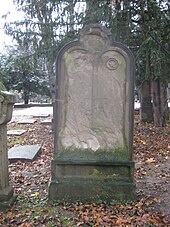

Karl Ludwig Wilhelm Zanth, from 1844 von Zanth, also Zandt (6 August 1796 – 7 October 1857) was a German architect, architecture critic and watercolor painter.
Life and career
Born in Breslau, Zanth was the son of the Jewish doctor Abraham Zadig, who was in the service of the Prince of Hohenlohe-Ingelfingen. The father converted to Christianity in 1820 and the family took the name "Zanth". Ludwig Zanth attended the art and building school in Breslau. In 1808, the family moved to Kassel. Thanks to a scholarship from the Kingdom of Westphalia, Zanth was able to attend the École polymatique and the Lycée Bonaparte in Paris in the summer and autumn of 1813. At the end of 1813, his father sent his son to Stuttgart, where he completed his school education, especially in the classical languages Latin and Greek, at the Gymnasium. Subsequently, Zanth completed an apprenticeship in the architectural office of the court master builder Ferdinand von Fischer. After stays in Schwäbisch Hall, Ellwangen and Paris, where he contributed to two theatre buildings and converted from the Protestant faith to Catholicism, he settled as an architect in Stuttgart in 1831. There he was responsible for the interior design of the Wilhelm Palais, which was built from 1834 to 1840. King Wilhelm I had this magnificent building, constructed in the classical style, built for his daughters Marie and Sophie.
In 1835, Zanth entered the competition for the construction of a new Royal Court Theatre in Stuttgart. However, the project was not realised. In 1835/36 he planned a house for ] [de] in Heilbronn, in 1836/37 the Berkheimer Schlössle [de] for Friedrich Notter [de] and in 1838 a country house for Wilhelm von Taubenheim [de]. In the same year, he drew up the plans for the Wilhelma Theatre in Bad Cannstatt, a building in the style of the French Renaissance with painting in the "Pompeian" style, which was completed in 1840. Subsequently, King Wilhelm I of Württemberg entrusted him with the planning and execution of a public bath in the midst of exotic greenhouses and parks in the immediate vicinity of the Wilhelma Theatre. From 1843 onwards, Zanth planned the Moorish style complex, which was named Wilhelma on the king's instructions, today the name of the zoological-botanical garden located there. It was inaugurated as the Maurisches Landhaus [de] in 1846. The magnificent building was such a success that the architect produced a large-format portfolio of coloured drawings about it. King Wilhelm I of Württemberg appointed him Court Architect and awarded him the Knight's Cross of the Order of the Crown in 1844. This was connected with his elevation to the personal nobility.
The architect was also a talented draughtsman. A still preserved watercolour in the Schloss ob Ellwangen [de] bears witness to his talent.

Zanth died in Stuttgart at the age of 59 and found his final resting place in the Hoppenlauf Cemetery [de]. However, the inscription on his gravestone has weathered beyond recognition.
Publications
- with Jacques Ignace Hittorff: Architecture antique de la Sicile ou recueil des plus intéressans monumens d'architecture des villes et des lieux les plus remarquables de la Sicile ancienne, mesurés et dessinés par J. Hittorff et L. Zanth. Paris (Numerized).
- with Jacques Ignace Hittorff: Architecture moderne de la Sicile ou Recueil des plus beaux monumens religieux et des édifices publics et particuliers les plus remarquables de la Sicile, mesurés et dessinés par J. J. Hittorf et L. Zanth Architectes. Paris 1835.
- with Jacques Ignace Hittorff: Architecture antique de la Sicile. Recueil des monumens de Ségeste et de Sélinonte, mesurés et dessinés par J.-I. Hittorff & L. Zanth, Texte avec un atlas de 89 planches. Paris 1870 (Numerized)
- Die Wilhelma. Maurische Villa Seiner Majestät des Königes Wilhelm von Württemberg. Entworfen und ausgeführt von Ludwig von Zanth. Autenrieth’sche Kunsthandlung, Stuttgart 1855–1856 (Numerized).
References
- David August Rosenthal: Convertitenbilder aus dem neunzehnten Jahrhundert. Vol.1. 2d Part. p. 47, Schaffhausen, 1872.
- History of Wilhelma - 19th century Website of the Wilhelma, retrieved 6 June 2021.
- "Alles, alles, dem König und uns" Monumente - Magazin für Denkmalkultur in Deutschland, October 2011, retrieved 6 June 2021.
Further reading
- Mathilde Boisserée: Sulpiz Boisserée. Briefwechsel/Tagebücher, 2 volumes. Stuttgart 1862, Faksimiledruck Göttingen 1970, vol. 1, pp. 790, 827–828, 848.
- Judith Breuer, Wolfgang Mayer, Helmut F. Reichwald: Erweckung aus dem Zauberschlaf. Zur Restaurierung des Wilhelmatheaters in Stuttgart-Bad Cannstatt. In Denkmalpflege in Baden-Württemberg 16, 2, 1987, pp. 65–86.
- Thomas L. Donaldson: Memoir of Louis Zanth. In: Papers read at the Royal Institute of British architects, Session 1857–58. London 1858, S. 15–18 (Numerized)
- Rolf Hofmann: Die Maurische Villa in der Königlichen Wilhelma Gartenanlage. Ein Rückblick auf das Leben des Architekten Ludwig Zanth. Ohne Ort und Jahr (Online)
- Karl Klöpping: Historische Friedhöfe Alt-Stuttgarts. Vol. 1: Sankt Jakobus bis Hoppenlau. Ein Beitrag zur Stadtgeschichte mit Wegweiser zu den Grabstätten des Hoppenlaufriedhofs. Stuttgart 1991, pp. 314–315, 317 N°. 1109.
- Georg Kaspar Nagler (collaborator.): Zanth, Ludwig von. In Neues allgemeines Künstler-Lexicon, vol. 22. Munich 1852, pp. 221–222. (Numerized)
- Bertold Pfeiffer: Der Hoppenlau-Friedhof in Stuttgart. Stuttgart 1912.
- Annemarie Roeder, Michael Wenger among others: Karl Ludwig von Zanth. Der Erbauer der Wilhelma in seiner Zeit. Begleitbuch zur Ausstellung im Haus der Heimat. Stuttgart 2012.
- Frank Scholze: Karl Ludwig Wilhelm von Zanth und die Wilhelma. Eine kurze Einführung zum 200. Geburtstag des Architekten. Stuttgart 1996 (Complete text)
- August Wintterlin (1898), "Zanth, Ludwig", Allgemeine Deutsche Biographie (in German), vol. 44, Leipzig: Duncker & Humblot, pp. 689–690
- Nekrolog des Dr. Ludwig v. Zanth, Königl. Würt. Hofbaumeister. In Schwäbische Kronik 3 January 1858, pp. 13f. – Nachdruck: Zeitschrift des Architekten- und Ingenieur-Vereins zu Hannover [de] 1858, Sp. 372–375 (Numerized)
External links
- Literature by and about Ludwig von Zanth in the German National Library catalogue
- Exhibition in Stuttgart
- Karl Ludwig Wilhelm von Zanth und die Wilhelma – zum 200. Geburtstag des Architekten (PDF; 112 kB)